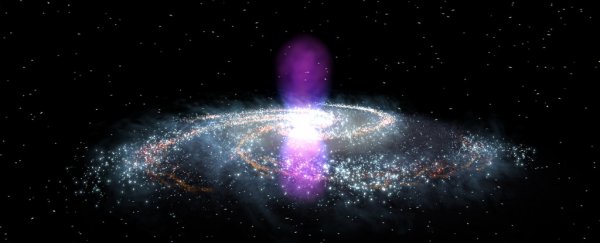There's a lot going on in the centre of our galaxy. The Milky Way's core is home to a supermassive black hole as massive as 4 million Suns called Sagittarius A*, and the environment around it is intense.
Blowing out from this region is a nuclear galactic wind. It's carved out two huge gamma-ray bubbles above and below the galactic plane, extending a total of 50,000 light-years into space. These Fermi bubbles are complex, containing a mix of different gases and cosmic rays.
But astronomers have just spotted something new. Within the Fermi bubbles are high-velocity clumps of cold molecular gas - the stuff that stars are made of. Even better, they're not sure how the galactic centre spat that gas out "like bullets", according to the researchers.
"The wind at the centre of the Milky Way has been the topic of plenty of debate since the discovery a decade ago of the so-called Fermi Bubbles," said astrophysicist Naomi McClure-Griffiths of The Australian National University.
"We've observed there's not only hot gas coming from the centre of our galaxy, but also cold and very dense gas. This cold gas is much heavier, so moves around less easily."
To find the clouds of dense, cold molecular gas, researchers studied previously identified clouds of atomic hydrogen in the bubbles, using the Atacama Pathfinder Experiment radio telescope to look for their spectral signature.
Sure enough, they found it in significant amounts: two clouds containing at least 380 and 375 solar masses' worth of molecular gas, and moving at 240 kilometres per second and 300 kilometres per second, respectively.
It seemed to be mixed in with the warmer medium, with the signature suggesting that the cold molecular gas could be in the process of being disrupted. This is fascinating, because such extremely cold, extremely dense molecular gas clouds are just what's required for star formation.
"Galaxies can be really good at shooting themselves in the foot," McClure-Griffiths said.
"When you drive out a lot of mass, you're losing some of the material that could be used to form stars, and if you lose enough of it, the galaxy can't form stars at all anymore. So, to be able to see hints of the Milky Way losing this star-forming gas is kind of exciting - it makes you wonder what's going to happen next!"
Where the Fermi bubbles are concerned, it's really an open question. These bubbles have been a puzzle since their discovery, because it's not clear what caused them. Whatever it was, it took place several million years ago, and there are two competing explanations.
The first is a burst of star formation in a cloud of molecular gas around Sgr A*, which would have produced a bunch of Type II supernovae and generated powerful stellar winds. This is one model whereby the galactic centre could have puffed two giant bubbles into space.
The second scenario - and one that seems to have more support - is that at some point a few million years ago, Sgr A* had a snack, swallowing a clump of material. Active accretion by a black hole can launch jets from the poles as material is channelled along the outside of the event horizon, or winds from the rapidly swirling disc of material as it spirals into the object.
We have observed similar processes in other galaxies, but they have not provided a solid answer. Distant galaxies often have larger, more active supermassive black holes, and higher rates of star formation, so they can hork out more material. They're also farther away, so we can't really see their bubbles in close detail.
This new research doesn't really answer the question either. In fact, it raises a big one - because neither star formation nor black hole accretion at the levels we have observed in the galactic centre seem to be a viable source.
It's possible that periodic star formation in the last 50 million years could partially explain the volume of gas being expelled, but models suggest that such clouds have quite a short lifespan - and it's not clear how long they would survive at high acceleration, especially in a hot wind.
It's also possible that the fast-moving cold gas could form directly within the outflow by mixing slow, cool clouds and fast, hot winds. This would solve several problems, but current simulations have been unable to replicate the entire process.
It's a thorny problem, and one that the team is continuing to look into, hoping to make targeted observations of molecular gas tracers within the nuclear wind in order to gain a more detailed understanding of how they're moving, and interacting with the hot gas around them.
"We're still looking for the smoking gun, but it gets more complicated the more we learn about it," said astrophysicist and lead author Enrico Di Teodoro from Johns Hopkins University.
The research has been published in Nature.
